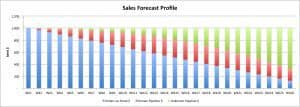Revenue Forecasts: Get it Right for the Short, Medium and Longer Term

Why Different Horizons Need Different Forecast Methods
What will your revenue be next week? Or next month? Or in six or 15 months time. Similar questions, but so completely different when you look at how to forecast them!
Next week’s revenue is pretty easy. You know what you’ve taken as orders and what you can deliver during the period to book as revenue. Or you’ve got a great feel for what is going on and what you expect to close over the week.
Next month is a bit harder to forecast revenue. Why? I hear you ask. Well it is a combination of what has been already taken as orders and what is likely to be sold, probably based on your existing orders or what your sales people have closing in the very short term which has a high probability attached to it.
Revenue in six months is different again. You probably don’t have orders for any of it, so you are relying on your pipeline, the efficacy of your sales team, the probabilities associated with an opportunity and the values assigned to them. Then you need to add on an allowance for the sales you have no idea about, but expect to land.
Then if we were to look 15 months forward, well most of that will not even be in a CRM system (if you use one), so it will all be stuff that you don’t know about now, but expect to happen.
If we were to graph this, it would look something like this.
The short term shows the orders on hand, yet to be deliverd, the medium term shows the conversion of your pipeline and the long term what we expect will eventuate (but have far less certainty).
Why is Good Revenue Forecasting Important
Why is this important? I can think of a few reasons.
The first is cash flow forecasting. If short term cash accuracy is important, then getting your forecast right for the next few weeks is vital.
Likewise, if you make a perishable product – like a newspaper, dairy or bakery items – once again, getting your short term forecast as accurate as possible will lead to increased gross profit and decreased working captial requirements.
Third, having a good sales forecast will allow you to plan delivery – either of services or products with greater confidence. You will have the right stock or capability available to meet the expected demand.
Finally (and of course most importantly for us bean counters 😉 ), is to get our financial forecasts in alignment with what the business is saying will happen.
How to Forecast Revenue for Different Horizons
This is where it gets harder. Obviously for each of the scenarios listed above you have different sources, namely:
- orders on hand – for the blue in the graph above,
- your crm for deals in the pipeline – the red, and
- your managers “feel” for the business – the green
Each of these needs to be loaded into your forecast. The tricky part is blending them.
For orders on hand, you know the expected delivery and thus recognition of revenue.
For opportunities in your pipeline, you have an expected close and from that, you should be able to work out when it is expected to be recognised as revenue. Simply taking the expected close period, the value and the probability of winning the deal will give some guidance to the value to assign.
For the rest, that is somewhat subjective and it should include adjustment for promotions, market conditions, customer demand, seasonality etc. This will also be at a higher level than the other forecasts, and possibly at a different granularity of time – maybe months rather than weeks.
We then should be able to simply aggregate the three buckets to derive an overall revenue forecast.
Triangulation
Tri-an-gu-what? Yeah, yeah. Once you have this forecast it is really important to then sanity check it. Ideally against two other independent forecasts.
So firstly, if you sell products, you are likely to have a demand forecast used to manage inventory. Take those volumes, multiply them by expected average selling prices and compare.
Secondly, talk directly to the finance people. They should have a forecast for the period covered. Compare that as well to the aggregate of the three buckets above.
These three forecasts will never equal. If they do, there’s a problem – your team is spending too much time playing with figures. But they should be in the same ball park. If they’re not, you have a bigger problem because that says that your sales people, demand planners, marketing or finance folk are not operating from the same song sheet.
Need help with TM1?
We're here for you



